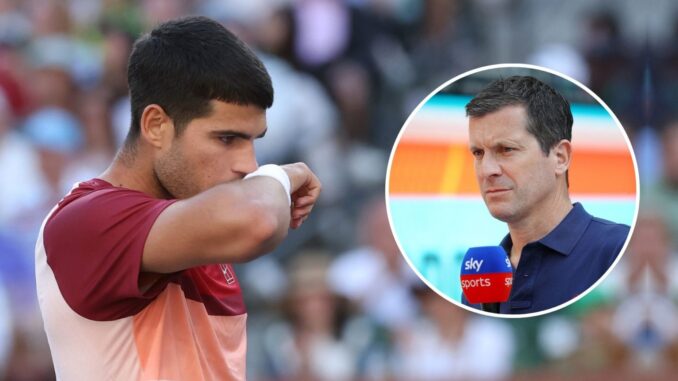
As the tennis world shifts its gaze to the red clay of the 2025 season, Carlos Alcaraz stands at a crossroads, his prodigious talent undeniable yet still ripe for refinement. The 21-year-old Spaniard, already a four-time Grand Slam champion, has dazzled fans with his electric athleticism and fearless shot-making, but Tim Henman, the former British number one turned sharp-eyed commentator, has pinpointed a single chink in Alcaraz’s otherwise gleaming armor: his shot selection. With the clay court swing looming—starting with the Monte Carlo Masters in April and culminating at Roland Garros in late May—Henman’s advice carries weight, offering a roadmap for Alcaraz to sharpen his game and solidify his dominance on the sport’s most grueling surface.
Alcaraz’s 2025 has been a mixed bag so far. He kicked off the year with a quarterfinal run at the Australian Open, only to fall to Novak Djokovic in four sets, a reminder of the Serbian’s enduring prowess. But redemption came swiftly in Rotterdam, where Alcaraz claimed his first indoor hardcourt title, beating Alex de Minaur in a thrilling three-set final. That victory made him the youngest man to win titles on all four modern surfaces—clay, grass, outdoor hard, and now indoor hard—at just 21 years and nine months. Yet, the hardcourt season took a turn in Indian Wells, where he lost a semifinal clash to Jack Draper despite a bagel set, and then stumbled in Miami, crashing out in his opener against David Goffin. These erratic performances have fueled debate about his consistency, and Henman isn’t shying away from the conversation.
“I definitely don’t see it as a moment of crisis,” Henman remarked, brushing off any notion of panic. He views Alcaraz’s recent struggles as part of a natural learning curve for a player still early in his journey. “He’s not playing his best tennis, but it’s all part of understanding yourself,” he added, emphasizing that growth, not perfection, is the goal at this stage. For Henman, the key to unlocking Alcaraz’s next level lies in one critical area: shot selection. “When he improves his shot selection, then he will become more consistent,” he explained, his tone measured yet optimistic. It’s a subtle but seismic tweak—choosing the right moment to unleash his flair rather than swinging for the fences every time.
Clay, with its slower pace and higher bounces, demands a different kind of discipline, one that could amplify Alcaraz’s strengths if he heeds Henman’s counsel. The Spaniard’s game is a spectacle: a blur of speed, spin, and power, with a forehand that can clock speeds rivaling some players’ serves. His 2024 French Open triumph—his first on the Parisian dirt—proved he’s no stranger to clay’s challenges, outlasting Jannik Sinner and Alexander Zverev in a grueling five-set final. But Henman sees room for refinement. Too often, Alcaraz opts for the extraordinary—a audacious drop shot or a crosscourt screamer—when a simpler play might suffice. On clay, where rallies stretch and patience is a virtue, that tendency could be his undoing against savvy veterans or rising stars like Draper, who’ve already shown they can exploit his lapses.
The clay season offers Alcaraz a fresh canvas. Monte Carlo, where he’ll make only his second appearance, kicks things off, followed by stops in Barcelona, Madrid, and Rome—tournaments where he’s already tasted success. “He’s one of the best players in the world,” Henman said, his confidence in Alcaraz unshaken. “He’s capable of winning any tournament he enters.” That belief stems from Alcaraz’s raw ability—his movement, likened by some to a young Rafael Nadal, and his versatility across surfaces. But consistency, Henman argues, is what separates the great from the legendary, and for Alcaraz, mastering shot selection could be the bridge to that elite tier.
As the tennis caravan rolls into Europe, Alcaraz carries the hopes of a nation and the scrutiny of a global audience. His rivalry with Sinner, who edged him out for the world number one spot in 2024, adds spice to the season ahead. Henman’s words aren’t a critique but a challenge—a call for Alcaraz to evolve without losing the magic that makes him must-watch tennis. If he can temper his flair with strategy, the clay courts of 2025 might just become his playground once more, cementing his status not just as a champion, but as a force for the ages. For now, the ball’s in his court—quite literally—and the world waits to see how he’ll play it.
Leave a Reply